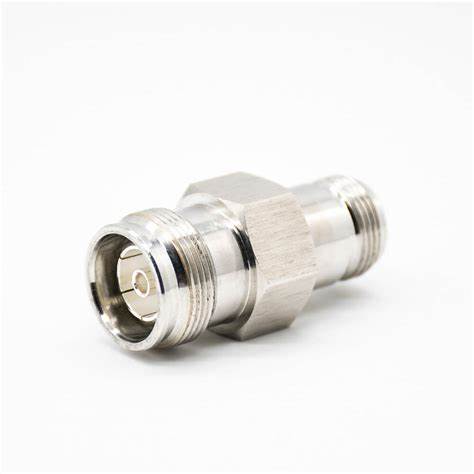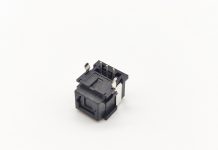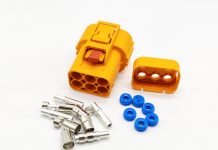The DIN 4.3/10 connector is small in size, and the hand-tightened and push-pull 4.3-10 connectors are in the installation process
No torque wrench is required, and dense packaging with interconnect spacing as small as 1 inch (2.54 cm) can be achieved. For the high-density multiple inputs, multiple outputs and antenna arrays used in the latest 4GLTE, 5G, small cells, and distributed antenna system applications, the high performance, reliability, and high packaging density of the 4.3-10 connector can provide large Most line infrastructure and mobile wireless equipment system can not realize the advantages.

The DIN 4.3/10 connector is small in size, and the hand-tightened and push-pull 4.3-10 connectors are in the installation process
No torque wrench is required, and dense packaging with interconnect spacing as small as 1 inch (2.54 cm) can be achieved. For the high-density multiple inputs, multiple outputs and antenna arrays used in the latest 4GLTE, 5G, small cells, and distributed antenna system applications, the high performance, reliability, and high packaging density of the 4.3-10 connector can provide large Most line infrastructure and mobile wireless equipment system can not realize the advantages.
A variety of coaxial connectors such as DIN7/16, N-type, 4.1/9.5, and 4.3-10 are used in wireless and wired networks. Under normal circumstances, the choice of the connector ultimately lies in the consideration of economy, power handling capacity, size and installation situation. However, the ever-increasing wireless network frequency bands and ever-increasing mobile data rates place very stringent requirements on transmission fidelity. This is especially true for the non-independent 5G New Radio (NSA5GNR) technology specified by 3GPP to be applied, which may affect the performance of the 4G system due to passive intermodulation (PIM) and other non-linear factors in the radio spectrum. New frequency bands have been added to the affected 3GHz and 5GHz segments. Therefore, in order to achieve the network performance goals of the latest wireless systems, the necessity for new coaxial connector interfaces such as 4.3-10 is becoming higher and higher.
Compared with the previous coaxial connectors, the 4.3-10 coaxial connector presents some important differences and has design features that the 4.1/9.5 connectors of similar size do not have. The most important feature of the 4.3-10 coaxial connector maybe the separation between the electrical mating surface and the mechanical mating surface. This feature enables this type of connector to be realized even when it is not fully tightened. Due to transmission and PIM performance. In addition, since the electrical contacts and electrical mating surfaces of the 4.3-10 coaxial connector are protected by the outer structure of the connector, it is more suitable for on-site installation. In addition to this, size is also an important feature. The 4.3-10 connector and its flange mounting part can be accommodated in a space of 1 square inch (6.45 square centimeters). In view of these characteristics, the 4.3-10 connector becomes the best choice for new systems and system transformations.

In addition to the separation of the above-mentioned two types of mating surfaces, the design feature of the 4.3-10 connector is that the coaxial electrical contacts are not coupled with the mechanical mating hardware. This means that the 4.3-10 connector does not require the same front-end contact force as the 7/16, N-type, or 4.1/9.5 connector. The 4.3-10 connector adopts a radial contact method, in which the best contact can be achieved even with a much smaller force. Therefore, the 4.3-10 connector does not need too much torsion force and can adopt screwing, hand-tightening, and push-pull mating methods, all of which do not affect its electrical performance. In addition, the finger-tight and push-pull 4.3-10 connectors allow the cable to rotate during installation, thereby reducing the complexity in complex wiring situations.
As mentioned above, in the 4.3-10 connector, since the electrical contact surface is provided inside the mechanical connection hardware, the contact surface can be protected during operation. This design feature prevents common electrical performance degradation such as increased insertion loss, PIM, and potential system failures caused by misoperation. In addition, this design method also enables the female/socket connector to be mated with any type of male/plug connection mechanism, thereby eliminating the need to design different female/receptacle connectors for each type of male/plug connection mechanism.
Due to the small size of the 4.3-10 connector, and the hand-tightened and push-pull 4.3-10 connector does not require a torque wrench during installation, this type of connector can achieve dense packaging with interconnecting spacing as small as 1 inch (2.54 cm). For the high-density multiple-input, multiple-output (MIMO), and antenna arrays used in the latest 4GLTE, 5G, small cells, and distributed antenna system (DAS) applications, the 4.3-10 connector has high performance, high reliability, and high Packing density characteristics can provide advantages that most wire infrastructure and mobile wireless device systems cannot achieve.
Elecbee is a shop that sells various electronic products. Our cable connectors are purchased from Chinese original equipment manufacturers with high quality and competitive prices. There are more questions you can leave us a message. Elecbee electronic engineers provide the most professional answers to help you choose the correct and safe connector.
























